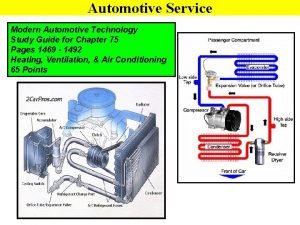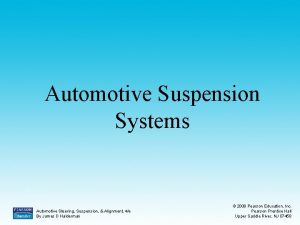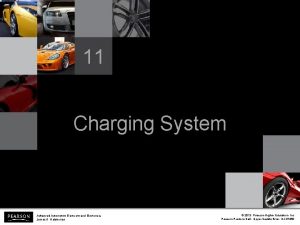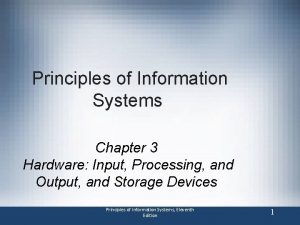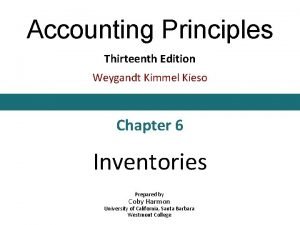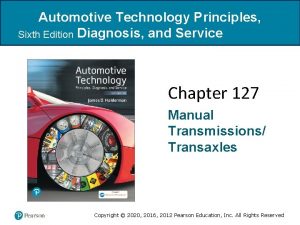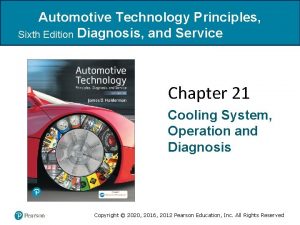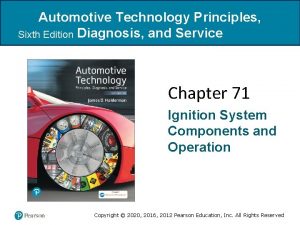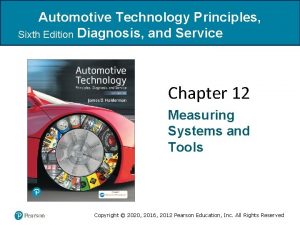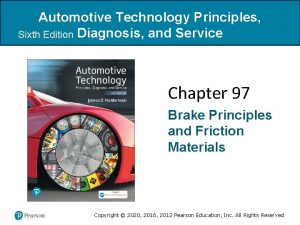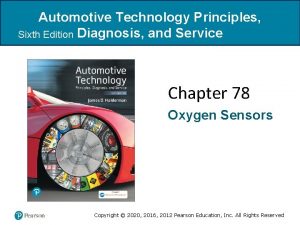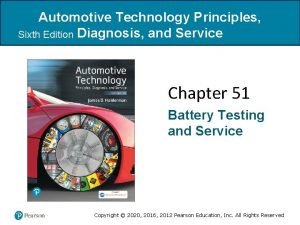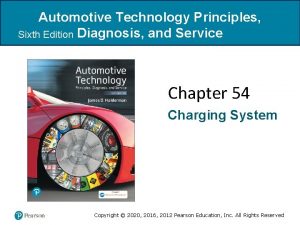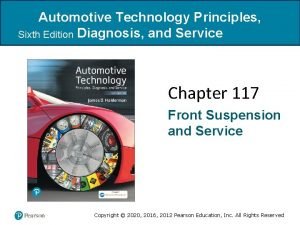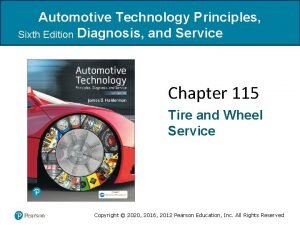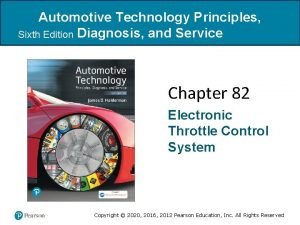Automotive Technology Principles Sixth Edition Diagnosis and Service









































































- Slides: 73

Automotive Technology Principles, Sixth Edition Diagnosis, and Service Chapter 45 Wiring Schematics and Circuit Testing Copyright © 2018, 2015, 2011 Pearson Education, Inc. All Rights Reserved Copyright © 2020, 2016, 2012 Pearson Education, Inc. All Rights Reserved

LEARNING OBJECTIVES (1 of 2) 45. 1 Interpret wiring schematics and explain the procedure to identify relay terminals. 45. 2 Locate shorts, grounds, opens, and resistance problems in electrical circuits, and determine necessary action. 45. 3 Explain the different methods to locate a short circuit, and the procedure to troubleshoot an electrical problem. Copyright © 2020, 2016, 2012 Pearson Education, Inc. All Rights Reserved

LEARNING OBJECTIVES (2 of 2) 45. 4 This chapter will help you prepare for the ASE Electrical/Electronic Systems (A 6) certification test content area “A” (General Electrical/Electronic System Diagnosis). Copyright © 2020, 2016, 2012 Pearson Education, Inc. All Rights Reserved

WIRING SCHEMATICS AND SYMBOLS (1 OF 2) • Terminology – A wiring schematic, sometimes called a diagram, shows electrical components and wiring using symbols and lines to represent components and wires. • All circuit schematics or diagrams include: – Power-side of wiring, splices, connectors, wire size, wire color, trace color, circuit number, electrical components, ground path returns, fuses and switches Copyright © 2020, 2016, 2012 Pearson Education, Inc. All Rights Reserved

WIRING SCHEMATICS AND SYMBOLS (2 OF 2) • Circuit Information – The first color or color abbreviation is the color of the wire insulation. – The second color (if mentioned) is the color of the stripe or tracer on the base color. • Wire Size – Wire size is shown on all schematics. – Metric wire gauge size in square millimeters (mm 2) – Standard wire using the AWG standard Copyright © 2020, 2016, 2012 Pearson Education, Inc. All Rights Reserved

Figure 45. 1 The center wire is a solid color wire, meaning that the wire has no other identifying tracer or stripe color. The two end wires could be labeled “BLU/WHT, ” indicating a blue wire with a white tracer or stripe Copyright © 2020, 2016, 2012 Pearson Education, Inc. All Rights Reserved

Chart 45 -1 Typical abbreviations used on schematics to show wire color. Some vehicle manufacturers use two letters to represent a wire color. Check service information for the color abbreviations used. Copyright © 2020, 2016, 2012 Pearson Education, Inc. All Rights Reserved

Figure 45. 2 Typical section of a wiring diagram. Notice that the wire color changes at connection C 210. The “ 0. 8” represents the metric wire size in square millimeters Copyright © 2020, 2016, 2012 Pearson Education, Inc. All Rights Reserved

Figure 45. 3 Typical electrical and electronic symbols used in automotive wiring and circuit diagrams. Both the conventional and the global symbols are shown side-by-side to make reading schematics easier. Copyright © 2020, 2016, 2012 Pearson Education, Inc. All Rights Reserved

QUESTION 1: ? What are the two ways the wire size may be displayed on the schematic? Copyright © 2020, 2016, 2012 Pearson Education, Inc. All Rights Reserved

ANSWER 1: mm 2 or AWG Standard. Copyright © 2020, 2016, 2012 Pearson Education, Inc. All Rights Reserved

SCHEMATIC SYMBOLS (1 OF 4) • Battery – The plates of a battery are represented by long and short lines. • Wiring – Electrical wiring is shown as straight lines and with a few numbers and/or letters to indicate the wire size, circuit number, wire color, splices, connectors and location. Copyright © 2020, 2016, 2012 Pearson Education, Inc. All Rights Reserved

SCHEMATIC SYMBOLS (2 OF 4) • Electrical Components – Most electrical components have their own unique symbol that shows the basic function or parts. • Electric Motors – An electric motor symbol shows a circle with the letter M in the center and two electrical connections, one at the top and the other at the bottom. Copyright © 2020, 2016, 2012 Pearson Education, Inc. All Rights Reserved

SCHEMATIC SYMBOLS (3 OF 4) • Resistors – A resistor symbol is a jagged line representing resistance to current flow. • Capacitors – If one of the lines is curved, this indicates that the capacitor being used has a polarity. • Electrically Heated Unit – The grid-like symbol represents an electrically heated element. Copyright © 2020, 2016, 2012 Pearson Education, Inc. All Rights Reserved

SCHEMATIC SYMBOLS (4 OF 4) • Boxed Components – A solid line, the box is the entire component. – Dashed lines, it represents part of a component. • Switches – Normally open – Normally closed – Momentary contact Copyright © 2020, 2016, 2012 Pearson Education, Inc. All Rights Reserved

TECH TIP Copyright © 2020, 2016, 2012 Pearson Education, Inc. All Rights Reserved

Figure 45. 4 In this typical connector, note that the positive terminal is usually a female connector Copyright © 2020, 2016, 2012 Pearson Education, Inc. All Rights Reserved

Figure 45. 5 The symbol for a battery. The positive plate of a battery is represented by the longer line and the negative plate by the shorter line. Copyright © 2020, 2016, 2012 Pearson Education, Inc. All Rights Reserved

Figure 45. 6 The ground symbol on the left represents an earth ground. The ground symbol on the right represents a chassis ground Copyright © 2020, 2016, 2012 Pearson Education, Inc. All Rights Reserved

Figure 45. 7 Starting at the top, the wire from the ignition switch is attached to terminal B of connector C 2, the wire is 0. 5 mm 2 (20 gauge AWG), and is yellow. The circuit number is 5. The wire enters connector C 202 at terminal B 3 Copyright © 2020, 2016, 2012 Pearson Education, Inc. All Rights Reserved

Figure 45. 8 The electrical terminals are usually labeled with a letter or number Copyright © 2020, 2016, 2012 Pearson Education, Inc. All Rights Reserved

Figure 45. 9 Two wires that cross at the dot indicate that the two are electrically connected Copyright © 2020, 2016, 2012 Pearson Education, Inc. All Rights Reserved

Figure 45. 10 Wires that cross, but do not electrically contact each other, are shown with one wire bridging over the other Copyright © 2020, 2016, 2012 Pearson Education, Inc. All Rights Reserved

Figure 45. 11 Connectors (C), grounds (G), and splices (S) are followed by a number, generally indicating the location in the vehicle. G 209 is under the dash. Copyright © 2020, 2016, 2012 Pearson Education, Inc. All Rights Reserved

Figure 45. 12 The ground for the battery is labeled G 305, indicating the ground connector is located in the passenger compartment of the vehicle. Copyright © 2020, 2016, 2012 Pearson Education, Inc. All Rights Reserved

Figure 45. 13 The symbol for lightbulbs shows the filament inside a circle, which represents the glass ampoule of the bulb Copyright © 2020, 2016, 2012 Pearson Education, Inc. All Rights Reserved

Figure 45. 14 An electric motor symbol shows a circle with the letter M in the center and two black sections that represent the brushes of the motor. Copyright © 2020, 2016, 2012 Pearson Education, Inc. All Rights Reserved

Figure 45. 15 Resistor symbols vary, depending on the type of resistor Copyright © 2020, 2016, 2012 Pearson Education, Inc. All Rights Reserved

Figure 45. 16 A rheostat uses only two wires—one is connected to a voltage source and the other is attached to the movable arm Copyright © 2020, 2016, 2012 Pearson Education, Inc. All Rights Reserved

Figure 45. 17 Symbols used to represent capacitors. If one of the lines is curved, this indicates that the capacitor being used has a polarity. Copyright © 2020, 2016, 2012 Pearson Education, Inc. All Rights Reserved

Figure 45. 18 The grid-like symbol represents an electrically heated element Copyright © 2020, 2016, 2012 Pearson Education, Inc. All Rights Reserved

Figure 45. 19 A dashed outline represents a portion (part) of a component Copyright © 2020, 2016, 2012 Pearson Education, Inc. All Rights Reserved

Figure 45. 20 A solid box represents an entire component Copyright © 2020, 2016, 2012 Pearson Education, Inc. All Rights Reserved

Figure 45. 21 This symbol represents a component that is case grounded Copyright © 2020, 2016, 2012 Pearson Education, Inc. All Rights Reserved

Figure 45. 22 (a) A symbol for a single-pole, single-throw (SPST) switch. This type of switch is normally open (N. O. ) because nothing is connected to the terminal that the switch is contacting in its normal position. (b) A single-pole, double-throw (SPDT) switch has three terminals. Copyright © 2020, 2016, 2012 Pearson Education, Inc. All Rights Reserved

Figure 45. 22(c) A double-pole, single-throw (DPST) switch has two positions (off and on) and can control two separate circuits. (d) A double-pole, double-throw (DPDT) switch has six terminals—three for each pole. Copyright © 2020, 2016, 2012 Pearson Education, Inc. All Rights Reserved

Figure 45. 23 (a) A symbol for a normally open (N. O. ) momentary switch Copyright © 2020, 2016, 2012 Pearson Education, Inc. All Rights Reserved

Figure 45. 23 (b) A symbol for a normally closed (N. C. ) momentary switch Copyright © 2020, 2016, 2012 Pearson Education, Inc. All Rights Reserved

TECH TIP Copyright © 2020, 2016, 2012 Pearson Education, Inc. All Rights Reserved

Figure 45. 24 (a) A typical headlight circuit showing the colors of the wires Copyright © 2020, 2016, 2012 Pearson Education, Inc. All Rights Reserved

Figure 45. 24 (b) A more complex circuit using colored pencils to indicate where there is voltage in the circuit will help diagnosis the system if there is a fault Copyright © 2020, 2016, 2012 Pearson Education, Inc. All Rights Reserved

QUESTION 2: ? How is an electrical motor identified on a schematic? Copyright © 2020, 2016, 2012 Pearson Education, Inc. All Rights Reserved

ANSWER 2: An electric motor symbol shows a circle with the letter M in the center and two black sections that represent the brushes of the motor. Copyright © 2020, 2016, 2012 Pearson Education, Inc. All Rights Reserved

RELAY TERMINAL IDENTIFICATION • A relay is a magnetic switch that uses a movable armature to control a high-amperage circuit by using a low amperage electrical switch. • ISO Relay Terminal Identification – Coil (Terminals 85 and 86) – Load (Terminals 30, 87 and 87 a) • Relay Spike Control – To reduce the induced voltage, some relays contain a diode connected across the coil. Copyright © 2020, 2016, 2012 Pearson Education, Inc. All Rights Reserved

Figure 45. 25 A relay uses a movable arm to complete a circuit whenever there is a power at terminal 86 and a ground at terminal 85. Copyright © 2020, 2016, 2012 Pearson Education, Inc. All Rights Reserved

Figure 45. 26 A cross-sectional view of a typical four-terminal relay. Current flowing through the coil (terminals 86 and 85) causes the movable arm (called the armature) to be drawn toward the coil magnet. Copyright © 2020, 2016, 2012 Pearson Education, Inc. All Rights Reserved

Figure 45. 27 A typical relay showing the schematic of the wiring in the relay Copyright © 2020, 2016, 2012 Pearson Education, Inc. All Rights Reserved

Figure 45. 28 All schematics are shown in their normal, non-energized position Copyright © 2020, 2016, 2012 Pearson Education, Inc. All Rights Reserved

Figure 45. 29 A horn circuit. Note that the relay contacts supply the heavy current to operate the horn when the horn switch simply completes a low-current circuit to ground, causing the relay contacts to close. Copyright © 2020, 2016, 2012 Pearson Education, Inc. All Rights Reserved

Figure 45. 30 When the relay or solenoid coil current is turned off, the stored energy in the coil flows through the clamping diode and effectively reduces voltage spike. Copyright © 2020, 2016, 2012 Pearson Education, Inc. All Rights Reserved

Figure 45. 31 A resistor used in parallel with the coil windings is a common spike reduction method used in many relays Copyright © 2020, 2016, 2012 Pearson Education, Inc. All Rights Reserved

LOCATING AN OPEN CIRCUIT • The typical procedure for locating an open circuit involves the following steps. – – Perform a thorough visual inspection. Print out the schematic. Check everything that does and does not work. Check for voltage. Copyright © 2020, 2016, 2012 Pearson Education, Inc. All Rights Reserved

COMMON POWER OR GROUND • When diagnosing an electrical problem that affects more than one component or system, check the electrical schematic for a common power source or a common ground. • Example: – – – Under-hood light Inside lighted mirrors Dome light Left-side courtesy light Right-side courtesy light Copyright © 2020, 2016, 2012 Pearson Education, Inc. All Rights Reserved

Figure 45. 32 A typical wiring diagram showing multiple switches and bulbs powered by one fuse Copyright © 2020, 2016, 2012 Pearson Education, Inc. All Rights Reserved

TECH TIP Copyright © 2020, 2016, 2012 Pearson Education, Inc. All Rights Reserved

Figure 45. 33 To additional lighting, simply tap into an existing light wire and connect a relay. Whenever the existing light is turned on, the coil of the relay is energized. Copyright © 2020, 2016, 2012 Pearson Education, Inc. All Rights Reserved

CIRCUIT TROUBLESHOOTING PROCEDURE • Example: Backup lights are inoperative – Verify the malfunction – Check for everything else that does not operate correctly – Check fuse for backup lights – Check for voltage at the backup light socket Copyright © 2020, 2016, 2012 Pearson Education, Inc. All Rights Reserved

Figure 45. 34 Always check the simple things first. Check the fuse for the circuit you are testing. Copyright © 2020, 2016, 2012 Pearson Education, Inc. All Rights Reserved

LOCATING A SHORT CIRCUIT (1 OF 3) • Definition – A short circuit is an electrical connection to another wire or to ground before the current flows through some or all of the resistance in the circuit. • Fuse Replacement Method – Disconnect one component at a time and then replace the fuse. Not the preferred method. • Circuit Breaker Method – The circuit breaker alternately opens and closes the circuit, protecting the wiring from overheating. Copyright © 2020, 2016, 2012 Pearson Education, Inc. All Rights Reserved

LOCATING A SHORT CIRCUIT (2 OF 3) • Test Light Method – Remove the blown fuse and connect a test light to the terminals of the fuse holder (polarity does not matter). • Buzzer Method – The buzzer method is similar to the test light method, but uses a buzzer to replace a fuse and act as an electrical load. • Ohmmeter Method – Remove power from the circuit and measure continuity to ground. Copyright © 2020, 2016, 2012 Pearson Education, Inc. All Rights Reserved

LOCATING A SHORT CIRCUIT (3 OF 3) • Gauss Method – A Gauss gauge is a handheld meter that responds to weak magnetic fields. • Circuit Tracer – The tone is generated as long as there is a continuous electrical path along the circuit. Copyright © 2020, 2016, 2012 Pearson Education, Inc. All Rights Reserved

Figure 45. 35 (a) After removing the blown fuse, a pulsing circuit breaker is connected to the terminals of the fuse Copyright © 2020, 2016, 2012 Pearson Education, Inc. All Rights Reserved

Figure 45. 35 (b) The circuit breaker causes current to flow, then stop, then flow again, through the circuit up to the point of the short-to-ground. Copyright © 2020, 2016, 2012 Pearson Education, Inc. All Rights Reserved

Figure 45. 36 A Gauss gauge can be used to determine the location of a short circuit even behind a metal panel Copyright © 2020, 2016, 2012 Pearson Education, Inc. All Rights Reserved

Figure 45. 37 A tone generator–type tester used to locate open circuits and circuits that are shorted-to-ground. Copyright © 2020, 2016, 2012 Pearson Education, Inc. All Rights Reserved

Figure 45. 38 To check for a short-to-ground using a tone generator, connect the black transmitter lead to a good chassis ground and the red lead to the load side of the fuse terminal. Copyright © 2020, 2016, 2012 Pearson Education, Inc. All Rights Reserved

QUESTION 3: ? How can a tone generator be used to locate a short circuit? Copyright © 2020, 2016, 2012 Pearson Education, Inc. All Rights Reserved

ANSWER 3: When the circuit is shorted the generator will emit a tone. Copyright © 2020, 2016, 2012 Pearson Education, Inc. All Rights Reserved

ELECTRICAL TROUBLESHOOTING GUIDE • When troubleshooting any electrical component, remember the following hints to identify the problem faster and more easily. – For a device to work, it must have power and ground. – If there is no power to a device, an open power side (blown fuse, etc. ) is indicated. – If there is power on both sides of a device, an open ground is indicated. – If a fuse blows immediately, a grounded power-side wire is indicated. Copyright © 2020, 2016, 2012 Pearson Education, Inc. All Rights Reserved

STEP-BY-STEP TROUBLESHOOTING • Determine the customer concern • Verify the customer’s concern • Perform a thorough visual inspection • Check for technical service bulletins (TSBs) • Locate the wiring schematic • Check the factory service information • Determine the root cause and repair the vehicle • Verify the repair Copyright © 2020, 2016, 2012 Pearson Education, Inc. All Rights Reserved

CASE STUDY Copyright © 2020, 2016, 2012 Pearson Education, Inc. All Rights Reserved

Figure 45. 39 Anti-static spray can be used by customers to prevent being shocked when they touch a metal object like the door handle Copyright © 2020, 2016, 2012 Pearson Education, Inc. All Rights Reserved

Copyright © 2020, 2016, 2012 Pearson Education, Inc. All Rights Reserved
 Automotive technology sixth edition
Automotive technology sixth edition Automotive technology sixth edition
Automotive technology sixth edition Principles of economics sixth edition
Principles of economics sixth edition The sixth sheik's sixth sheep's sick
The sixth sheik's sixth sheep's sick The sixth sick sheik's sixth sheep's sick lyrics
The sixth sick sheik's sixth sheep's sick lyrics Automotive heating and air conditioning 8th edition
Automotive heating and air conditioning 8th edition Biochemistry sixth edition 2007 w.h. freeman and company
Biochemistry sixth edition 2007 w.h. freeman and company Automotive engines 8th edition
Automotive engines 8th edition China automotive technology & research center
China automotive technology & research center Computer architecture a quantitative approach sixth edition
Computer architecture a quantitative approach sixth edition Apa sixth edition
Apa sixth edition Computer architecture a quantitative approach sixth edition
Computer architecture a quantitative approach sixth edition Precalculus sixth edition
Precalculus sixth edition Computer architecture a quantitative approach sixth edition
Computer architecture a quantitative approach sixth edition Ongoing planning in nursing process
Ongoing planning in nursing process Medical diagnosis and nursing diagnosis difference
Medical diagnosis and nursing diagnosis difference Nursing diagnosis three parts
Nursing diagnosis three parts Types of nursing diagnoses
Types of nursing diagnoses Modern automotive technology answer key
Modern automotive technology answer key Automotive technology chapter 51 answers
Automotive technology chapter 51 answers Structural mechanics exam questions
Structural mechanics exam questions Center for advanced automotive technology
Center for advanced automotive technology Mechanical technology automotive grade 10
Mechanical technology automotive grade 10 Sixth sense technology seminar report
Sixth sense technology seminar report Sixth sense technology seminar
Sixth sense technology seminar Ted sixth sense
Ted sixth sense Perbedaan diagnosis gizi dan diagnosis medis
Perbedaan diagnosis gizi dan diagnosis medis Chapter 81 brake system diagnosis service and repair
Chapter 81 brake system diagnosis service and repair Mis chapter 6
Mis chapter 6 Using mis 10th edition
Using mis 10th edition Computer security principles and practice 4th edition
Computer security principles and practice 4th edition Computer security principles and practice 4th edition
Computer security principles and practice 4th edition Expert systems: principles and programming, fourth edition
Expert systems: principles and programming, fourth edition Kasavana and smith matrix
Kasavana and smith matrix Food and beverage service' 9 th edition
Food and beverage service' 9 th edition Food and beverage management 5th edition pdf
Food and beverage management 5th edition pdf Food and beverage service' 9 th edition
Food and beverage service' 9 th edition Food and beverage service' 9 th edition
Food and beverage service' 9 th edition Qqq tea
Qqq tea Information technology project management 9th edition
Information technology project management 9th edition Information technology project management 9th edition ppt
Information technology project management 9th edition ppt Ethics in information technology 6th edition answers
Ethics in information technology 6th edition answers Ethics in information technology fourth edition
Ethics in information technology fourth edition Project management quality control
Project management quality control Information technology project management 9th edition
Information technology project management 9th edition Basic environmental technology 6th edition pdf
Basic environmental technology 6th edition pdf Information technology project management 9th edition
Information technology project management 9th edition Automotive regulations and standards
Automotive regulations and standards Chapter 44 automotive wiring and wire repair
Chapter 44 automotive wiring and wire repair 4e alignment
4e alignment Advanced automotive electronics
Advanced automotive electronics Chapter 2 automotive careers and ase certification
Chapter 2 automotive careers and ase certification Auto upkeep answer key
Auto upkeep answer key Automotive fasteners gaskets and sealants
Automotive fasteners gaskets and sealants Fasteners gaskets seals and sealants
Fasteners gaskets seals and sealants Automotive bearings and seals
Automotive bearings and seals Principles of information security 5th edition pdf
Principles of information security 5th edition pdf Principles of electronic communication systems 3rd edition
Principles of electronic communication systems 3rd edition Principles of economics third edition oxford pdf
Principles of economics third edition oxford pdf Accounting principles second canadian edition
Accounting principles second canadian edition Accounting principles second canadian edition
Accounting principles second canadian edition Accounting principles second canadian edition
Accounting principles second canadian edition Principle of management by stephen p robbins
Principle of management by stephen p robbins Involuntary inactive real estate license florida
Involuntary inactive real estate license florida Principles of business information systems
Principles of business information systems Principles of information systems 11th edition
Principles of information systems 11th edition Ranked vulnerability risk worksheet
Ranked vulnerability risk worksheet Principles of marketing fifth european edition
Principles of marketing fifth european edition Beginning inventory formula
Beginning inventory formula Accounting principles second canadian edition
Accounting principles second canadian edition 12 principles of information security
12 principles of information security Bulls eye model in information security
Bulls eye model in information security Keys to effective internal marketing
Keys to effective internal marketing Florida real estate principles practices
Florida real estate principles practices


















